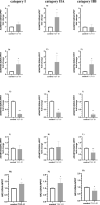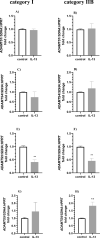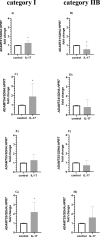Transcriptomic profiling of mare endometrium at different stages of endometrosis
- PMID: 37758834
- PMCID: PMC10533846
- DOI: 10.1038/s41598-023-43359-5
Transcriptomic profiling of mare endometrium at different stages of endometrosis
Abstract
In the current study, transcriptome profiles of mare endometrium, classified into categories I, IIA, and IIB according to Kenney and Doig, were compared using RNA sequencing, analyzed, and functionally annotated using in silico analysis. In the mild stage (IIA) of endometrosis compared to category I endometrium, differentially expressed genes (DEGs) were annotated to inflammation, abnormal metabolism, wound healing, and quantity of connective tissue. In the moderate stage (IIB) of endometrosis compared to category I endometrium, DEGs were annotated to inflammation, fibrosis, cellular homeostasis, mitochondrial dysfunction, and pregnancy disorders. Ingenuity pathway analysis (IPA) identified cytokines such as transforming growth factor (TGF)-β1, interleukin (IL)-4, IL-13, and IL-17 as upstream regulators of DEGs associated with cellular homeostasis, metabolism, and fibrosis signaling pathways. In vitro studies showed the effect of these cytokines on DEGs such as ADAMTS1, -4, -5, -9, and HK2 in endometrial fibroblasts at different stages of endometrosis. The effect of cytokines on ADAMTS members' gene transcription in fibroblasts differs according to the severity of endometrosis. The identified transcriptomic changes associated with endometrosis suggest that inflammation and metabolic changes are features of mild and moderate stages of endometrosis. The changes of ADAMTS-1, -4, -5, -9, in fibrotic endometrium as well as in endometrial fibroblast in response to TGF-β1, IL-4, IL-13, and IL-17 suggest the important role of these factors in the development of endometrosis.
© 2023. The Author(s).
Conflict of interest statement
The authors declare no competing interests.
Figures







Similar articles
-
Effect of proinflammatory cytokines on endometrial collagen and metallopeptidase expression during the course of equine endometrosis.Cytokine. 2019 Nov;123:154767. doi: 10.1016/j.cyto.2019.154767. Epub 2019 Jun 29. Cytokine. 2019. PMID: 31265984
-
Effect of transforming growth factor -β1 on α-smooth muscle actin and collagen expression in equine endometrial fibroblasts.Theriogenology. 2019 Jan 15;124:9-17. doi: 10.1016/j.theriogenology.2018.10.005. Epub 2018 Oct 4. Theriogenology. 2019. PMID: 30321755
-
Lysophosphatidic acid as a regulator of endometrial connective tissue growth factor and prostaglandin secretion during estrous cycle and endometrosis in the mare.BMC Vet Res. 2020 Sep 17;16(1):343. doi: 10.1186/s12917-020-02562-6. BMC Vet Res. 2020. PMID: 32943074 Free PMC article.
-
Physiopathologic mechanisms involved in mare endometrosis.Reprod Domest Anim. 2014 Oct;49 Suppl 4:82-7. doi: 10.1111/rda.12397. Reprod Domest Anim. 2014. PMID: 25277436 Review.
-
IIB or not IIB, part 1: retrospective evaluation of Kenney-Doig categorization of equine endometrial biopsies at a veterinary diagnostic laboratory and comparison with published reports.J Vet Diagn Invest. 2022 Mar;34(2):206-214. doi: 10.1177/10406387211062207. Epub 2021 Nov 28. J Vet Diagn Invest. 2022. PMID: 34841986 Free PMC article. Review.
Cited by
-
The myometrial transcriptome changes in mares with endometrosis.Sci Rep. 2025 Jan 25;15(1):3173. doi: 10.1038/s41598-025-86742-0. Sci Rep. 2025. PMID: 39863666 Free PMC article.
-
Co-occurrence of endometriosis with psoriasis and psoriatic arthritis: Genetic insights (Review).Exp Ther Med. 2025 Jul 10;30(3):171. doi: 10.3892/etm.2025.12921. eCollection 2025 Sep. Exp Ther Med. 2025. PMID: 40718089 Free PMC article. Review.
-
The effect of lysophosphatidic acid on myometrial contractility and the mRNA transcription of its receptors in the myometrium at different stages of endometrosis in mares.BMC Vet Res. 2024 Dec 19;20(1):571. doi: 10.1186/s12917-024-04384-2. BMC Vet Res. 2024. PMID: 39696406 Free PMC article.
-
Extracellular vesicles secreted by equine adipose mesenchymal stem cells preconditioned with transforming growth factor β-1 are enriched in anti-fibrotic miRNAs and inhibit the expression of fibrotic genes in an in vitro system of endometrial stromal cells fibrosis.Vet Q. 2024 Dec;44(1):1-11. doi: 10.1080/01652176.2024.2384906. Epub 2024 Jul 31. Vet Q. 2024. PMID: 39086189 Free PMC article.
-
The path to fertility: Current approaches to mare endometritis and endometrosis.Anim Reprod. 2024 Sep 13;21(3):e20240070. doi: 10.1590/1984-3143-AR2024-0070. eCollection 2024. Anim Reprod. 2024. PMID: 39286368 Free PMC article.
References
-
- Kenney RM. Cyclic and pathologic changes of the mare endometrium as detected by biopsy, with a note on early embryonic death. J. Am. Vet. Med. Assoc. 1978;172:241–262. - PubMed
-
- Kenney RM, Doig PA. Equine endometrial biopsy. In: Morrow DA, editor. Current Therapy in Theriogenology. Saunders WB; 1986. pp. 726–29.
Publication types
MeSH terms
Substances
LinkOut - more resources
Full Text Sources
Miscellaneous

